

Compact Muon Solenoid
LHC, CERN
| CMS-HIN-15-001 ; CERN-EP-2016-248 | ||
| Suppression of $\Upsilon$(1S), $\Upsilon$(2S), and $\Upsilon$(3S) quarkonium states in PbPb collisions at ${\sqrt{{s_{_{\mathrm{NN}}}}}} = $ 2.76 TeV | ||
| CMS Collaboration | ||
| 4 November 2016 | ||
| Phys. Lett. B 770 (2017) 357 | ||
| Abstract: The production yields of $\Upsilon$(1S), $\Upsilon$(2S), and $\Upsilon$(3S) quarkonium states are measured through their decays into muon pairs in the CMS detector, in PbPb and pp collisions at the centre-of-mass energy per nucleon pair of 2.76 TeV. The data correspond to integrated luminosities of 166 $\mu$b$^{-1}$ and 5.4 pb$^{-1}$ for PbPb and pp collisions, respectively. Differential production cross sections are reported as functions of $\Upsilon$ rapidity $y$ up to 2.4, and transverse momentum $p_{\mathrm{T}}$ up to 20 GeV/$c$. A strong centrality-dependent suppression is observed in PbPb relative to pp collisions, by factors of up to ${\approx} 2$ and 8, for the $\Upsilon$(1S) and $\Upsilon$(2S) states, respectively. No significant dependence of this suppression is observed as a function of $y$ or $p_{\mathrm{T}}$. The $\Upsilon$(3S) state is not observed in PbPb collisions, which corresponds to a suppression for the centrality-integrated data by at least a factor of ${\approx} 7$ at a 95% confidence level. The observed suppression is in agreement with theoretical scenarios modeling the sequential melting of quarkonium states in a quark gluon plasma. | ||
| Links: e-print arXiv:1611.01510 [hep-ex] (PDF) ; CDS record ; inSPIRE record ; HepData record ; CADI line (restricted) ; | ||
| Figures | |
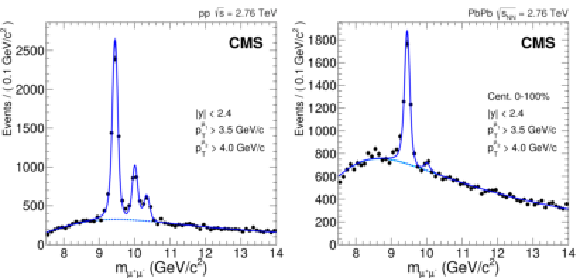
png pdf |
Figure 1:
Dimuon invariant mass distributions in pp (left) and centrality-integrated PbPb (right) data at $ {\sqrt {{s_{_{\mathrm {NN}}}}}} = $ 2.76 TeV, for muon pairs having one ${p_{\mathrm {T}}}$ greater than 4 GeV/$c$ and the other greater than 3.5 GeV/$c$. The solid (signal + background) and dashed (background only) lines show the result of fits described in the text. |
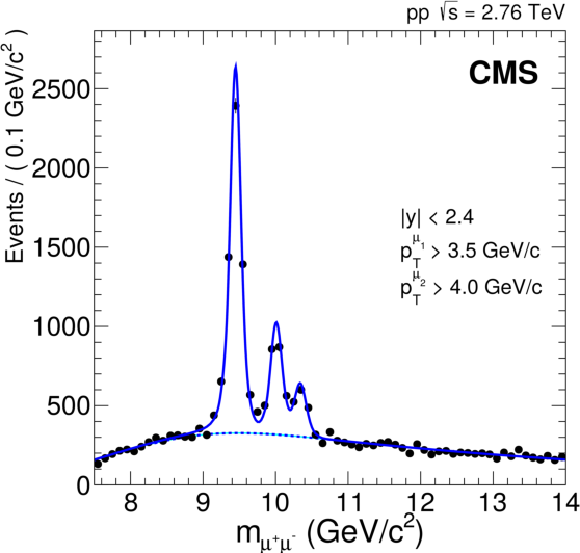
png pdf |
Figure 1-a:
Dimuon invariant mass distributions in pp data at $ {\sqrt {{s_{_{\mathrm {NN}}}}}} = $ 2.76 TeV, for muon pairs having one ${p_{\mathrm {T}}}$ greater than 4 GeV/$c$ and the other greater than 3.5 GeV/$c$. The solid (signal + background) and dashed (background only) lines show the result of fits described in the text. |
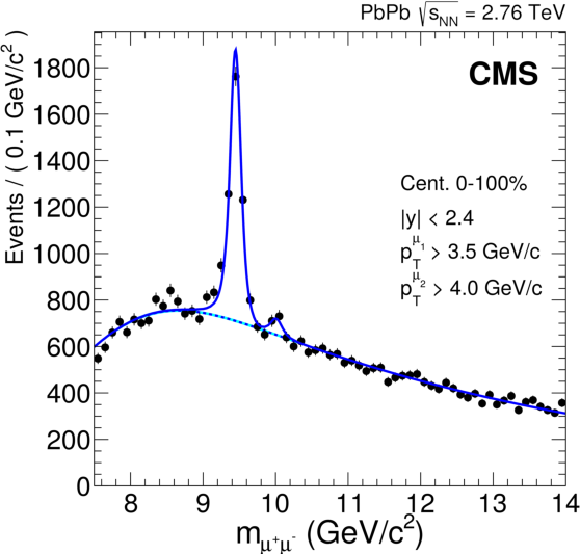
png pdf |
Figure 1-b:
Dimuon invariant mass distributions incentrality-integrated PbPb data at $ {\sqrt {{s_{_{\mathrm {NN}}}}}} = $ 2.76 TeV, for muon pairs having one ${p_{\mathrm {T}}}$ greater than 4 GeV/$c$ and the other greater than 3.5 GeV/$c$. The solid (signal + background) and dashed (background only) lines show the result of fits described in the text. |
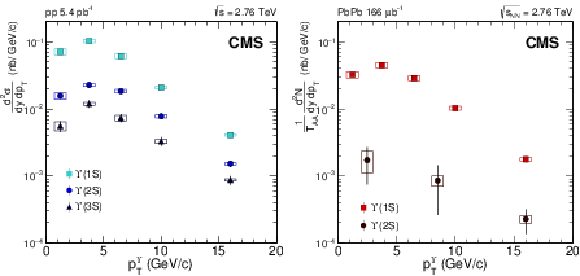
png pdf |
Figure 2:
Differential cross section for $\Upsilon$ states as a function of their transverse momentum and per unit of rapidity in pp (left) and PbPb (right) collisions. Statistical (systematic) uncertainties are displayed as error bars (boxes). Global relative uncertainties of 3.7% (pp) and 6.5% (PbPb) are not displayed. |
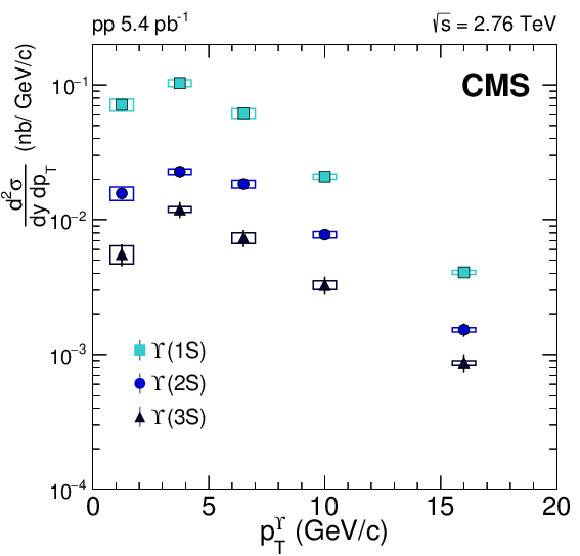
png pdf |
Figure 2-a:
Differential cross section for $\Upsilon$ states as a function of their transverse momentum and per unit of rapidity in pp collisions. Statistical (systematic) uncertainties are displayed as error bars (boxes). Global relative uncertainties of 3.7% (pp) and 6.5% (PbPb) are not displayed. |
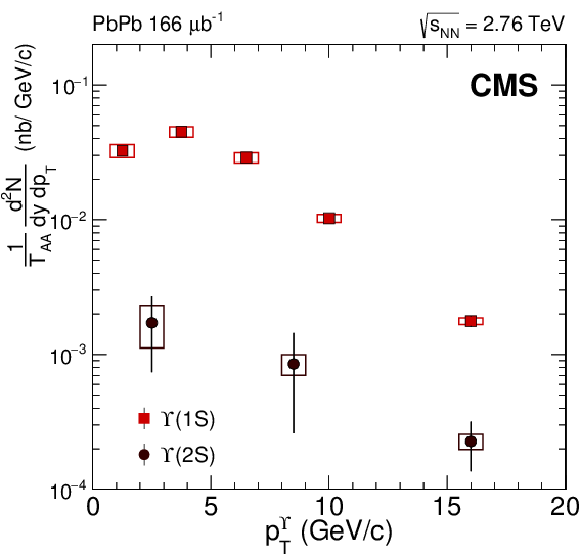
png pdf |
Figure 2-b:
Differential cross section for $\Upsilon$ states as a function of their transverse momentum and per unit of rapidity in PbPb collisions. Statistical (systematic) uncertainties are displayed as error bars (boxes). Global relative uncertainties of 3.7% (pp) and 6.5% (PbPb) are not displayed. |
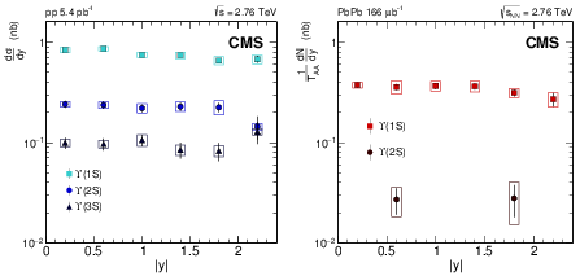
png pdf |
Figure 3:
Differential cross section for $\Upsilon$ states as a function of their rapidity and integrated over transverse momentum in pp (left) and PbPb (right) collisions. Statistical (systematic) uncertainties are displayed as error bars (boxes). Global relative uncertainties of 3.7% (pp) and 6.5% (PbPb) are not displayed. |
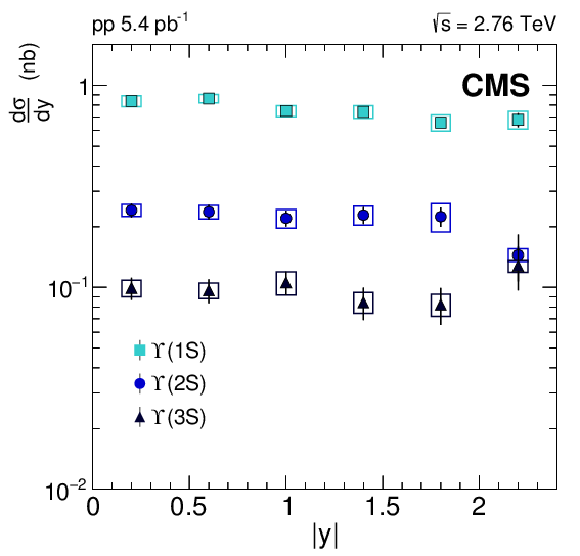
png pdf |
Figure 3-a:
Differential cross section for $\Upsilon$ states as a function of their rapidity and integrated over transverse momentum in pp collisions. Statistical (systematic) uncertainties are displayed as error bars (boxes). Global relative uncertainties of 3.7% (pp) and 6.5% (PbPb) are not displayed. |
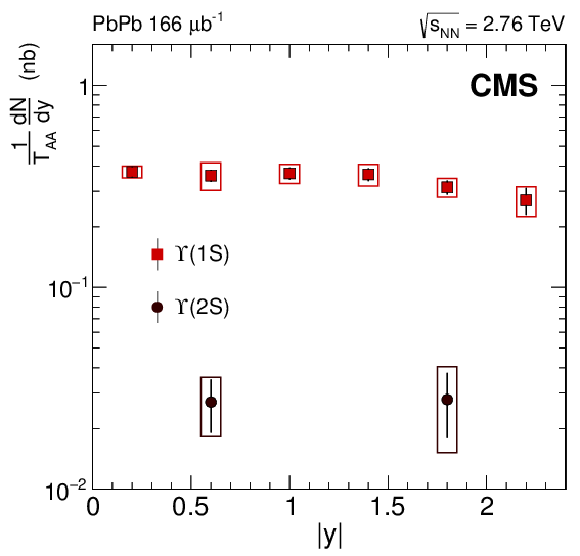
png pdf |
Figure 3-b:
Differential cross section for $\Upsilon$ states as a function of their rapidity and integrated over transverse momentum in PbPb collisions. Statistical (systematic) uncertainties are displayed as error bars (boxes). Global relative uncertainties of 3.7% (pp) and 6.5% (PbPb) are not displayed. |
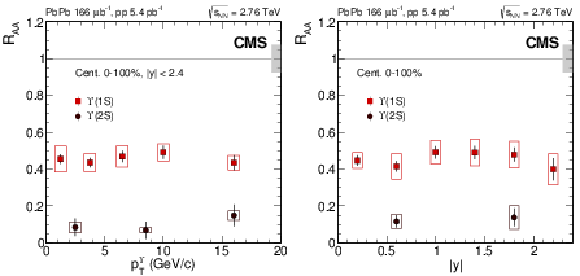
png pdf |
Figure 4:
Nuclear modification factor for $\Upsilon$(1S) and $\Upsilon$(2S) states in PbPb collisions as a function of ${p_{\mathrm {T}}}$ (left) and $ {| y | }$ (right). Statistical (systematic) uncertainties are displayed as error bars (boxes), while the global (fully correlated) uncertainty (7.5%) is displayed as a grey box at unity. |

png pdf |
Figure 4-a:
Nuclear modification factor for $\Upsilon$(1S) and $\Upsilon$(2S) states in PbPb collisions as a function of ${p_{\mathrm {T}}}$. Statistical (systematic) uncertainties are displayed as error bars (boxes), while the global (fully correlated) uncertainty (7.5%) is displayed as a grey box at unity. |
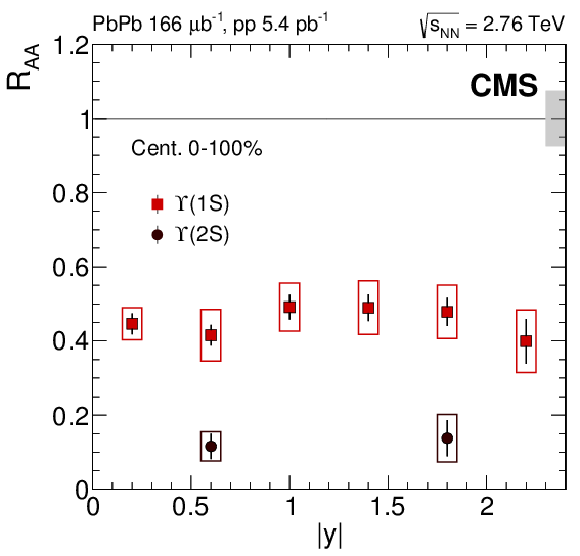
png pdf |
Figure 4-b:
Nuclear modification factor for $\Upsilon$(1S) and $\Upsilon$(2S) states in PbPb collisions as a function of $ {| y | }$. Statistical (systematic) uncertainties are displayed as error bars (boxes), while the global (fully correlated) uncertainty (7.5%) is displayed as a grey box at unity. |
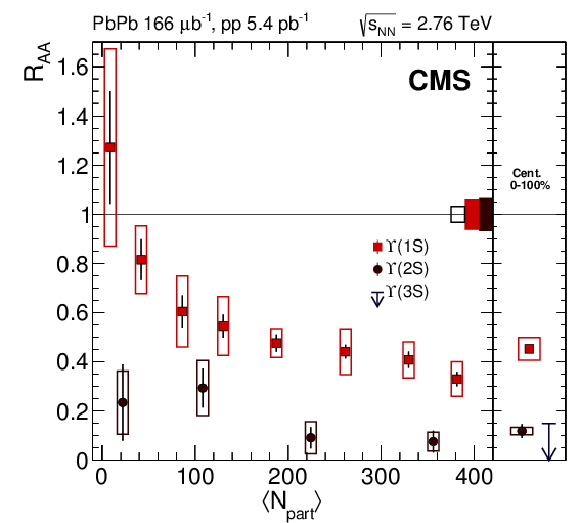
png pdf |
Figure 5:
Nuclear modification factors for $\Upsilon$(1S) and $\Upsilon$(2S) meson production in PbPb collisions, as a function of centrality, displayed as the average number of participating nucleons. The upper limit derived on the nuclear modification factor for $\Upsilon$(3S) is represented with an arrow in the centrality integrated panel. Statistical (systematic) uncertainties are displayed as error bars (boxes), while the global (fully correlated) uncertainties from the PbPb data (3.2%) or from the pp reference (6.3 and 6.9% for $\Upsilon$(1S) and $\Upsilon$(2S) states, respectively) are displayed at unity as empty, filled red, and filled black boxes, respectively. |
| Tables | |

png pdf |
Table 1:
Average values of the number of participating nucleons ($ {N_{\text {part}}} $, with the root-mean-square of its distribution in each bin), and nuclear overlap function ($ {T_\mathrm {AA}} $, with its systematic uncertainty) for the $\Upsilon$(1S) (upper), $\Upsilon$(2S) (middle) and centrality-integrated binning (last row). |
| Summary |
| The $\Upsilon$(1S), $\Upsilon$(2S), and $\Upsilon$(3S) yields have been measured in PbPb and pp collisions at ${\sqrt{{s_{_{\mathrm{NN}}}}}} = $ 2.76 TeV with the CMS detector, using integrated luminosities of 166 $\mu$b$^{-1}$ and 5.4 pb$^{-1}$, respectively. For the first time, differential production cross sections are derived for individual $\Upsilon$ states as functions of their rapidity and transverse momentum in heavy ion collisions. The $\Upsilon$(1S) and $\Upsilon$(2S) states are suppressed in PbPb relative to pp collisions scaled by the number of nucleon-nucleon collisions, by factors of ${\approx}2$ and 8, respectively, while the absence of a significant $\Upsilon$(3S) signal corresponds to a suppression by a factor larger than ${\approx}7$ at a 95% confidence level. While a strong centrality dependence of the suppression is found for the $\Upsilon$(1S) and $\Upsilon$(2S) states, no clear dependence is observed as a function of either transverse momentum or rapidity. The level of suppression measured in this analysis is compatible with theoretical models of a sequential melting of quarkonium states in a hot medium. |
| References | ||||
| 1 | F. Karsch and E. Laermann | Thermodynamics and in-medium hadron properties from lattice QCD | in Quark-Gluon Plasma III, R. C. Hwa and X.-N. Wang, eds World Scientific Publishing Co. Pte. Ltd. | hep-lat/0305025 |
| 2 | E. V. Shuryak | Theory of Hadronic Plasma | Sov. Phys. JETP 47 (1978)212 | |
| 3 | T. Matsui and H. Satz | $ \mathrm{J}/\psi $ suppression by quark-gluon plasma formation | PLB 178 (1986) 416 | |
| 4 | S. Digal, P. Petreczky, and H. Satz | Quarkonium feed down and sequential suppression | PRD 64 (2001) 094015 | hep-ph/0106017 |
| 5 | \'A. M\'ocsy and P. Petreczky | Color Screening Melts Quarkonium | PRL 99 (2007) 211602 | 0706.2183 |
| 6 | R. L. Thews, M. Schroedter, and J. Rafelski | Enhanced $ \mathrm{J}/\psi $ production in deconfined quark matter | PRC 63 (2001) 054905 | hep-ph/0007323 |
| 7 | A. Andronic, P. Braun-Munzinger, K. Redlich, and J. Stachel | Statistical hadronization of heavy quarks in ultra-relativistic nucleus-nucleus collisions | Nucl. Phys. A 789 (2007) 334 | nucl-th/0611023 |
| 8 | S. Gavin and R. Vogt | Charmonium Suppression by Comover Scattering in Pb+Pb Collisions | PRL 78 (1997) 1006 | hep-ph/9606460 |
| 9 | A. Capella, A. Kaidalov, A. Kouider Akil, and C. Gerschel | $ \mathrm{J}/\psi $ and $ {\psi}' $ suppression in heavy ion collisions | PLB 393 (1997) 431 | hep-ph/9607265 |
| 10 | R. Vogt | Cold nuclear matter effects on $ \mathrm{J}/\psi $ and $ \Upsilon $ production at energies available at the CERN Large Hadron Collider (LHC) | PRC 81 (2010) 044903 | 1003.3497 |
| 11 | F. Arleo and S. Peign\'e | Quarkonium suppression in heavy-ion collisions from coherent energy loss in cold nuclear matter | JHEP 10 (2014) 73 | 1407.5054 |
| 12 | A. Emerick, X. Zhao, and R. Rapp | Bottomonia in the quark-gluon plasma and their production at RHIC and LHC | EPJA 48 (2012) 72 | 1111.6537 |
| 13 | M. Strickland and D. Bazow | Thermal Bottomonium suppression at RHIC and LHC | Nucl. Phys. A 879 (2012) 25 | 1112.2761 |
| 14 | A. Andronic et al. | Heavy-flavour and quarkonium production in the LHC era: from proton-proton to heavy-ion collisions | EPJC 76 (2016) 107 | 1506.03981 |
| 15 | CMS Collaboration | Suppression of non-prompt $ \mathrm{J}/\psi, $ prompt $ \mathrm{J}/\psi, $ and $ \Upsilon $(1S) in PbPb collisions at $ \sqrt{s_{\rm NN}}=2.76 $ TeV | JHEP 05 (2012) 063 | CMS-HIN-10-006 1201.5069 |
| 16 | ALICE Collaboration | Suppression of $ \Upsilon (1S) $ at forward rapidity in Pb-Pb collisions at $ \sqrt{s_{\rm NN}} = 2.76 $ TeV | PLB 738 (2014) 361 | 1405.4493 |
| 17 | CMS Collaboration | Indications of Suppression of Excited $ \Upsilon $ States in Pb-Pb Collisions at $ \sqrt{s_{\rm NN}} $ = 2.76 TeV | PRL 107 (2011) 052302 | CMS-HIN-11-007 1105.4894 |
| 18 | CMS Collaboration | Observation of Sequential Upsilon Suppression in PbPb Collisions | PRL 109 (2012) 222301 | CMS-HIN-11-011 1208.2826 |
| 19 | ALICE Collaboration | Production of inclusive $ \Upsilon $(1S) and $ \Upsilon $(2S) in p-Pb collisions at $ \sqrt{s_{\rm NN}} = 5.02 $ TeV | PLB 740 (2014) 105 | 1410.2234 |
| 20 | LHCb Collaboration | Study of $ \Upsilon $ production and cold nuclear matter effects in pPb collisions at $ \sqrt{s_{\rm NN}}=5 $~TeV | JHEP 07 (2014) 094 | 1405.5152 |
| 21 | CMS Collaboration | Event activity dependence of Y(nS) production in $ \sqrt{s_{\rm NN}}=5.02 $ TeV pPb and $ \sqrt{s}=2.76 $ TeV pp collisions | JHEP 04 (2014) 103 | CMS-HIN-13-003 1312.6300 |
| 22 | STAR Collaboration | Suppression of $ \Upsilon $ production in d+Au and Au+Au collisions at $ \sqrt{s_{\rm NN}}=200 $GeV | PLB 735 (2014) 127, , [Erratum: \DOI 10.1016/j.physletb.2015.01.046] | 1312.3675 |
| 23 | CMS Collaboration | The CMS experiment at the CERN LHC | JINST 3 (2008) S08004 | CMS-00-001 |
| 24 | CMS Collaboration | Measurement of momentum scale and resolution using low-mass resonances and cosmic ray muons | CDS | |
| 25 | CMS Collaboration | Observation and studies of jet quenching in PbPb collisions at nucleon-nucleon center-of-mass energy = 2.76 TeV | PRC 84 (2011) 024906 | CMS-HIN-10-004 1102.1957 |
| 26 | CMS Collaboration | Luminosity Calibration for the 2013 Proton-Lead and Proton-Proton Data Taking | CMS-PAS-LUM-13-002 | CMS-PAS-LUM-13-002 |
| 27 | M. L. Miller, K. Reygers, S. J. Sanders, and P. Steinberg | Glauber modeling in high-energy nuclear collisions | Ann. Rev. Nucl. Part. Sci. 57 (2007) 205 | nucl-ex/0701025 |
| 28 | CMS Collaboration | Performance of CMS muon reconstruction in pp collision events at $ \sqrt{s}=7 $ TeV | JINST 7 (2012) P10002 | CMS-MUO-10-004 1206.4071 |
| 29 | M. J. Oreglia | A study of the reactions $\psi' \to \gamma\gamma \psi$ | PhD thesis, Stanford University, 1980 SLAC Report SLAC-R-236, see Appendix D | |
| 30 | CMS Collaboration | Measurement of the $ \Upsilon(1S), \Upsilon(2S) $, and $ \Upsilon(3S) $ cross sections in pp collisions at $ \sqrt{s} $ = 7 TeV | PLB 727 (2013) 101 | CMS-BPH-11-001 1303.5900 |
| 31 | Particle Data Group, K. A. Olive et al. | Review of Particle Physics | CPC 38 (2014) 090001 | |
| 32 | T. Sj\"ostrand, S. Mrenna, and P. Skands | PYTHIA 6.4 physics and manual | JHEP 05 (2006) 026 | hep-ph/0603175 |
| 33 | I. P. Lokhtin and A. M. Snigirev | A model of jet quenching in ultrarelativistic heavy ion collisions and high-$ p_{\mathrm{T}} $ hadron spectra at RHIC | EPJC 45 (2006) 211 | hep-ph/0506189 |
| 34 | E. Barberio, B. van Eijk, and Z. Was | PHOTOS: A universal Monte Carlo for QED radiative corrections in decays | CPC 66 (1991) 115 | |
| 35 | G. J. Feldman and R. D. Cousins | A unified approach to the classical statistical analysis of small signals | PRD 57 (1998) 3873 | physics/9711021 |
| 36 | B. Krouppa and M. Strickland | Predictions for bottomonia suppression in 5.023 TeV Pb-Pb collisions | Universe 2 (2016) 16 | 1605.03561 |

|
Compact Muon Solenoid LHC, CERN |

|

|

|

|

|

|